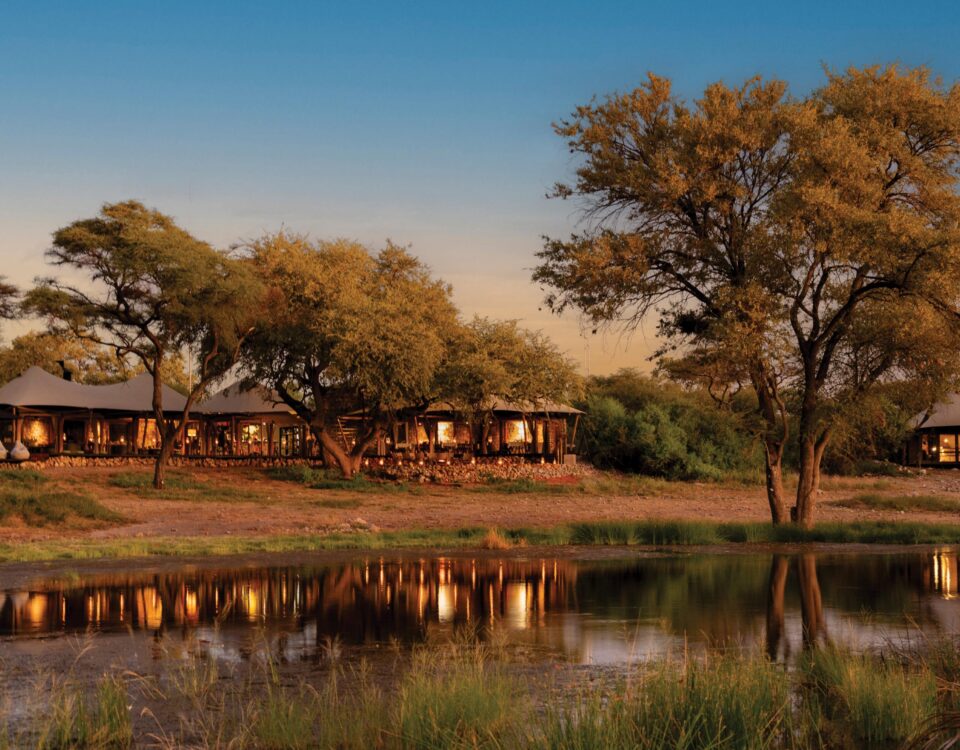Rustig Toko Lodge – A place to linger longer
July 19, 2012Welcome to Andersson’s Camp
July 19, 2012by Ginger Mauney
Africa is a land of myths and legends, some true, some false, and some so deeply embedded that they become defining. This is true of the Hai||om Bushmen, the original inhabitants of Etosha National Park, known as the Treesleepers.
Legend has it that in the old days when the Hai||om still used to hunt, they sometimes climbed trees not to be caught by lions. With patient lions surrounding the bases of the trees, they occasionally had to shelter in the branches overnight, and a legend and name were born.
Today Treesleeper is also the name of a community-based campsite that the Hai||om community, supported by the Foundation for Sustainable Tourism in Namibia (FSTN) from Holland and the Tsintsabis Trust in Namibia, has developed.
Located near the small village of Tsintsabis in north-eastern Namibia within easy driving distance of Etosha National Park, Treesleeper Camp has six private campsites. Each of the three sites has its own warm-water ablution facility and tree deck; two sites have shared ablution facilities and a tree deck; and one is a standard campsite. All campsites have their own private braai area, a tap and a bin.
The tree decks make these campsites uniquely appropriate to this area. In a loft in the branches, guests can spend long, leisurely hours imagining what it would be like to be trapped in a tree with lions prowling around below.
As George Tsam, who organises activities at the camp and is a member of the Tsintsabis Trust, explains, “This is just one of the cultural connections found at Treesleeper. We offer guests guided bushwalks, the chance to visit the local village where they are free to ask the Hai||om questions about their past and how they live today, and there is also the opportunity to enjoy traditional dancing and singing around a fire at night or at a nearby school.”
In the early morning Tsam or another local or locally trained Hai||om guide leads guests through the surrounding bush, pointing out various edible, poisonous and medicinal plants used by the Bushmen. Guests see first-hand how the local Bushmen used to hunt animals, set up traps and make fire.
“Most of our guests do the bushwalk. It is their favourite activity because they learn a lot and it is very practical,” said Tsam.
Guests may also spend a few hours on a guided visit to two nearby Bushman villages to see how the Hai||om live nowadays and learn more about the contemporary situation. Questions are welcomed and guests are free to take photographs, but mustn’t expect to see Bushmen dressed in traditional clothes. As Tsam stressed, “This tour is about real life.”
Traditional singing and dancing is another activity that guests can experience. Two very different groups – the children of Tsintsabis Junior Secondary School and an elderly traditional healing group – perform singing, dancing, healing and other ceremonies.
“We tend to alternate between these two different groups, so that each gets a chance to earn money,” remarked Tsam. Monies raised by the children help support cultural activities at the school, while the elderly, who are often those most in need, are paid directly.
It is preferable that guests book these activities in advance to avoid disappointment. Also, apart from the extremely reasonable fee for the village tour, guests are asked to bring a small gift of appreciation for the families they visit. This can be anything from a T-shirt, a bag of sugar or a packet of tea, but must not be money. This support, in exchange for entering their houses and gardens and for taking pictures, is an agreement between Treesleeper Camp, their guests and the community.
“At first the members of the community didn’t understand the project,” said Tsam, “but as the year went by with more meetings with the villagers and more visits from tourists who buy the traditional items the Hai||om make, they began to see the advantages.”
“We also employ local people to build and manage the camp,” added Tsam. A cultural centre is currently under construction at Treesleeper Camp and should be finished soon. It will be a place where guests can relax and purchase basic camping necessities. It will also house exhibits of traditional Bushman artefacts, provide information on the Hai||om, and serve as a place for the local Bushmen to sell their traditional crafts.
In just two years, Treesleeper Camp has attracted tourists from Germany, Italy, France and the United States, and their remarks in the guest book reflect satisfaction with the campsites and activities.
“People here are very proud of their culture, and even the other guides from Namibia who visit us learn something from their visit,” acknowledged Tsam. “And leave with smiles on their faces.”
This article appeared in the April ‘07 edition of Travel News Namibia.


